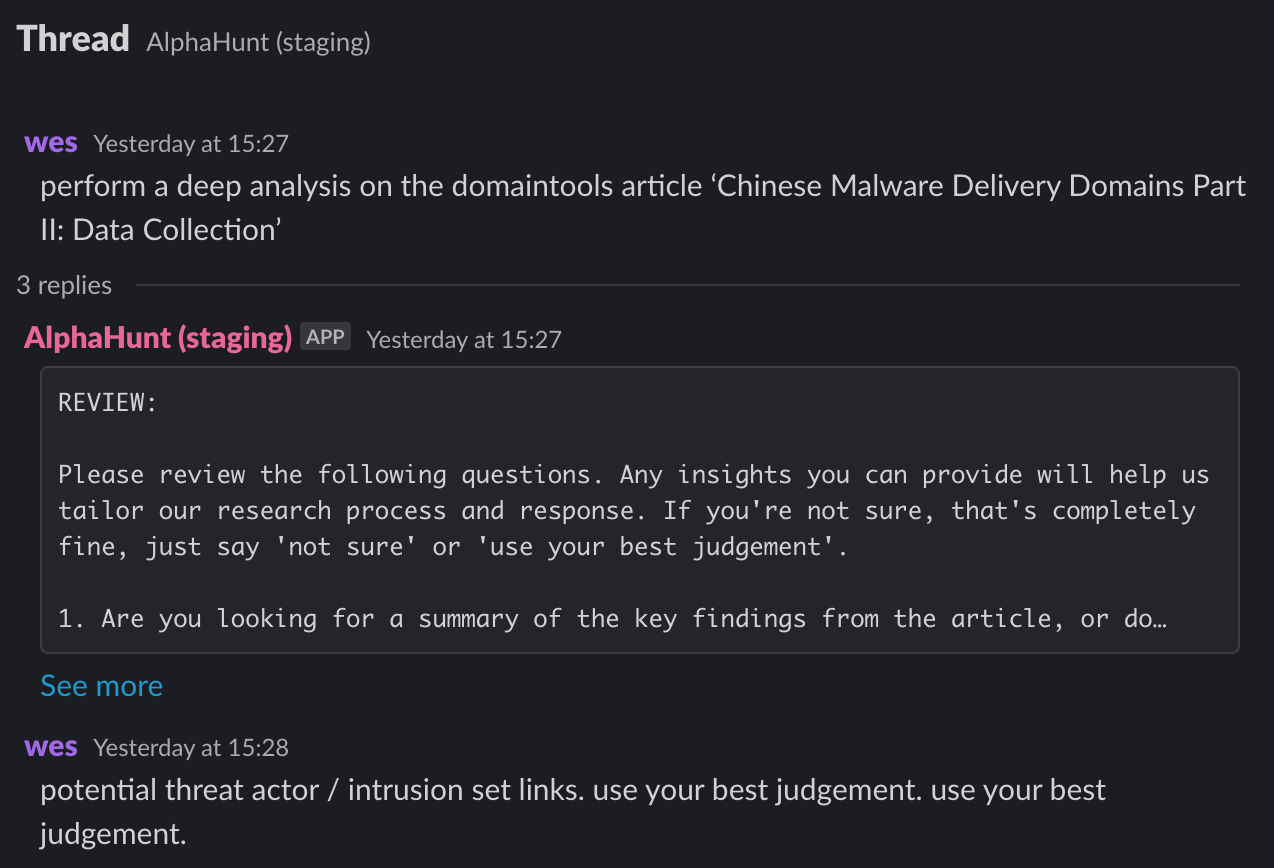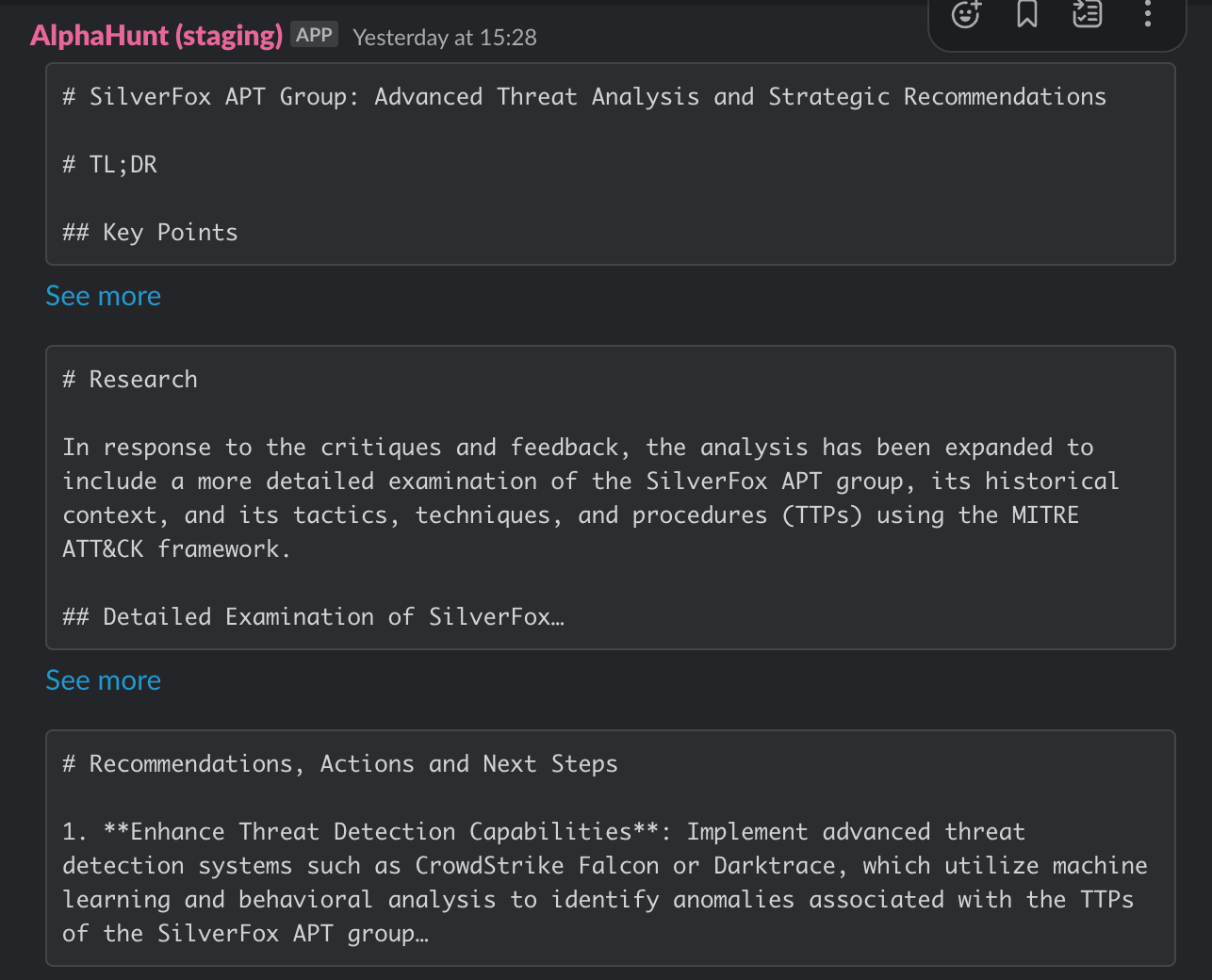SilverFox APT Group: Advanced Threat Analysis and Strategic Recommendations
The SilverFox APT group is a sophisticated cyber threat actor known for its espionage and cybercrime campaigns, primarily targeting Chinese-speaking individuals and organizations.

EDITOR'S NOTE: I'm testing the next generation of the AlphaHunt- the research goes a bit deeper, a bit more directed and a bit more "peer" reviewed. The layout may still need some work... feedback welcome (just hit reply! :))
The other day, I was skimming a great post by my friends at DomainTools and wondered, which threat actors / intrusion sets this could be related to?
Now- before you flame me for speculating, you should know something about me- I love speculating. I love thinking about probabilities in terms of which threads to pull next. It gives me something highly probable to start with (vs randomly flipping a coin)... and there was no way I was going to spend days trying to tease this out.. I have a short attention span, for better or worse.
So, I asked AlphaHunt to research the article with a bent towards linkable threat actors, accurate or otherwise, this is what came of it. Even if it's not 100% accurate:
✅ I learned something about another threat actor (with very low effort)
✅ The article (and research) is now in my intelligence graph (automatically)
✅ If I research similar threat actors (or TTPs) in the future, AlphaHunt will remind me of this article (including the DomainsTools article).
✅ I have more cycles to learn about other badness, while AlphaHunt connects the dots!
H/T: DomainTools for the great research! Cheers!
Thanks for taking the time to subscribe and read these, if they bring you value, let me know!


reading is hard- bots are easy. we like easy, right?
TL;DR
Key Points
- SilverFox APT group is known for targeting Chinese-speaking individuals and organizations using sophisticated malware like ValleyRAT.
- Enhance threat detection systems to identify anomalies associated with SilverFox's tactics.
- The group employs social engineering and exploits software vulnerabilities to deliver malware.
- Conduct targeted phishing awareness training to mitigate risks.
- SilverFox's tactics align with the MITRE ATT&CK framework, including application layer protocol use and credential theft.
- Implement multi-factor authentication and regular system updates to protect against these tactics.
- The group may expand its targeting beyond Chinese-speaking individuals, potentially focusing on multinational corporations.
- Develop incident response playbooks and collaborate with threat intelligence communities for proactive defense.
Summary
The SilverFox APT group is a sophisticated cyber threat actor known for its espionage and cybercrime campaigns, primarily targeting Chinese-speaking individuals and organizations. The group utilizes advanced malware, such as ValleyRAT, and employs social engineering tactics to exploit software vulnerabilities. Their tactics, techniques, and procedures (TTPs) align with the MITRE ATT&CK framework, including the use of application layer protocols and credential theft.
To counter these threats, organizations should enhance their threat detection capabilities, conduct targeted phishing awareness training, and implement multi-factor authentication. Regular system updates and the development of incident response playbooks are also crucial. Additionally, collaboration with threat intelligence sharing communities can provide valuable insights into SilverFox's evolving tactics.
In the short term, SilverFox is expected to intensify its focus on financial sectors and adopt new evasion techniques. In the long term, the group may expand its targeting to include multinational corporations and integrate ransomware tactics into their operations. Organizations should implement advanced threat hunting techniques and enhance monitoring for indicators of compromise to stay ahead of these evolving threats.
Research
Detailed Examination of SilverFox APT Group
- Overview:
- SilverFox is an advanced persistent threat (APT) group known for its espionage and cybercrime campaigns, primarily targeting Chinese-speaking individuals and organizations.
- The group has been linked to various malware families, including ValleyRAT, which is capable of evading detection and is used in sophisticated cyber operations.
- Historical Context:
- SilverFox has been active for several years, focusing on exploiting vulnerabilities in software to deliver malware to victims.
- Their campaigns often involve the use of social engineering tactics to lure users into downloading malicious software.
- Tactics, Techniques, and Procedures (TTPs):
- The group employs a range of techniques that align with the MITRE ATT&CK framework, including:
- T1071: Application Layer Protocol - Using common protocols to communicate with command and control (C2) servers.
- T1555: Credentials from Password Stores - Targeting stored credentials to gain unauthorized access.
- T1204: User Execution - Relying on user interaction to execute malicious payloads.
- T1059: Command and Scripting Interpreter - Utilizing scripts to automate tasks and execute commands on compromised systems.
- The group employs a range of techniques that align with the MITRE ATT&CK framework, including:
- Related Threat Actor Groups:
- ValleyRAT: This malware is closely associated with SilverFox, showcasing similar tactics and targeting methods. It is a complex multi-stage malware used in various campaigns attributed to SilverFox.
- Void Arachne: Another group that shares motivations and targets with SilverFox, focusing on Chinese-speaking users and employing advanced techniques in their cyber campaigns.
Recommendations, Actions and Next Steps
- Enhance Threat Detection Capabilities: Implement advanced threat detection systems such as CrowdStrike Falcon or Darktrace, which utilize machine learning and behavioral analysis to identify anomalies associated with the TTPs of the SilverFox APT group. Configure these tools to monitor for unusual application layer protocol communications (T1071) and user execution patterns (T1204). By enhancing detection capabilities, the organization can proactively identify potential intrusions before they escalate.
- Conduct Targeted Phishing Awareness Training: Given SilverFox's reliance on social engineering tactics, conduct regular training sessions for employees, particularly those in finance and accounting departments, to recognize phishing attempts and suspicious downloads. This training should include simulations of common attack vectors used by SilverFox, such as fake software downloads and malicious email attachments. Incorporate case studies from recent incidents to illustrate the potential impact of successful phishing attacks.
- Implement Multi-Factor Authentication (MFA): To mitigate the risk of credential theft (T1555), enforce multi-factor authentication across all critical systems. This additional layer of security will help protect against unauthorized access, even if credentials are compromised. Consider using solutions like Duo Security or Microsoft Authenticator, which are widely recognized for their effectiveness.
- Regularly Update and Patch Systems: Ensure that all software and systems are regularly updated and patched to protect against known vulnerabilities that SilverFox may exploit. This includes monitoring for CVEs related to the software used within the organization and applying patches promptly. Utilize tools like Qualys or Tenable for vulnerability management to streamline this process.
- Develop Incident Response Playbooks: Create and regularly update incident response playbooks specifically tailored to address potential attacks from SilverFox and similar APT groups. These playbooks should outline clear steps for containment, eradication, and recovery, as well as communication protocols for internal and external stakeholders. Include lessons learned from past incidents involving SilverFox to enhance the playbooks' relevance.
- Collaborate with Threat Intelligence Sharing Communities: Engage with threat intelligence sharing communities such as the Cyber Threat Alliance or Information Sharing and Analysis Centers (ISACs) to stay informed about the latest tactics and indicators of compromise (IOCs) associated with SilverFox and related groups like ValleyRAT and Void Arachne. This collaboration can provide valuable insights and enhance the organization's overall threat posture.
- Conduct Red Team Exercises: Regularly conduct red team exercises that simulate attacks from SilverFox to test the organization's defenses and incident response capabilities. These exercises should focus on the specific TTPs identified in the analysis, allowing the organization to identify weaknesses and improve its security posture. Use frameworks like MITRE ATT&CK to guide the scenarios.
- Monitor for Indicators of Compromise (IOCs): Establish a robust monitoring system for IOCs associated with SilverFox, ValleyRAT, and Void Arachne. This includes tracking known malware signatures, C2 server addresses, and other relevant indicators to facilitate early detection of potential threats. Utilize threat intelligence platforms like Recorded Future or ThreatConnect to automate IOC monitoring.
Followup Research
Questions
- What specific software vulnerabilities, such as those in Microsoft Office or Adobe products, have been historically exploited by the SilverFox APT group, and how can we proactively address these vulnerabilities in our systems?
- How do the TTPs of SilverFox compare to those of other APT groups targeting Chinese-speaking individuals, such as Void Arachne, and what unique strategies can we adopt to defend against them?
- What are the latest developments in the ValleyRAT malware, including its variants and delivery methods, and how can we enhance our detection capabilities to identify these threats more effectively?
- What recent indicators of compromise (IOCs) have been identified for SilverFox and its associated malware, and how can we integrate these into our monitoring systems to prevent potential breaches?
- What have been the consequences of ineffective phishing awareness training in organizations targeted by SilverFox, and what best practices can we implement to improve our training and reduce the risk of successful breaches?
- What specific case studies or incidents involving SilverFox can provide insights into their operational patterns, and how can these lessons be applied to refine our incident response playbooks?
- How can collaboration with threat intelligence sharing communities, such as the Cyber Threat Alliance, enhance our understanding of SilverFox's evolving tactics and improve our overall threat posture?
Forecasts
Short-Term Forecast (3-6 months)
- Increased Targeting of Financial Sectors
- The SilverFox APT group is expected to intensify its focus on financial and accounting departments within organizations, leveraging advanced malware like ValleyRAT. Recent reports indicate that this malware is being used to exploit vulnerabilities in these sectors, particularly through phishing attacks and malicious downloads disguised as legitimate software. The group's tactics include using social engineering to trick employees into executing malicious payloads, which can lead to significant data breaches and financial losses.
- Examples:
- A recent campaign highlighted by Morphisec Threat Labs shows ValleyRAT targeting accounting departments with new delivery techniques, indicating a strategic shift towards high-value targets within organizations.
- The use of fake Google Chrome sites to distribute ValleyRAT malware demonstrates the group's evolving tactics to bypass traditional security measures.
- Adoption of New Evasion Techniques
- SilverFox is likely to adopt more sophisticated evasion techniques to avoid detection by security systems. This includes the use of PowerShell commands and LNK files to execute malware from command and control (C2) servers. The group's ability to adapt and refine its methods will pose a significant challenge for cybersecurity defenses, necessitating organizations to enhance their monitoring and detection capabilities.
- Examples:
- The emergence of a new ValleyRAT variant that utilizes PowerShell for execution indicates a shift towards more stealthy and effective attack methods.
- Reports of the group blending in with cybercrime activities suggest a strategic approach to obfuscate their true intentions and evade law enforcement.
Long-Term Forecast (12-24 months)
- Expansion of Targeting Beyond Chinese-Speaking Individuals
- Over the next 12-24 months, SilverFox is expected to expand its targeting beyond Chinese-speaking individuals and organizations, potentially focusing on multinational corporations and critical infrastructure sectors. This shift may be driven by geopolitical tensions, particularly in the Asia-Pacific region, where competition for economic dominance is intensifying. The group's desire to gather intelligence on global economic activities and technological advancements could motivate this expansion.
- Examples:
- Historical patterns of APT groups suggest that as they gain confidence and resources, they often broaden their attack surface to include more diverse targets.
- The increasing sophistication of their malware and tactics indicates a potential pivot towards more strategic espionage operations against high-value targets globally.
- Integration of Ransomware Tactics and Potential Collaborations
- SilverFox may begin integrating ransomware tactics into their operations, similar to other state-aligned APT groups. This could lead to a dual-threat model where they not only steal data but also hold it for ransom, significantly increasing the impact of their attacks on organizations. Additionally, potential collaborations with other APT groups could emerge, allowing SilverFox to leverage shared resources and intelligence, enhancing their operational capabilities.
- Examples:
- The trend of state-aligned APT groups deploying ransomware as a means of financial gain is on the rise, and SilverFox could adopt similar strategies to enhance their operational effectiveness.
- The group's historical focus on espionage may evolve to include financial motivations, reflecting a broader trend in the cyber threat landscape.
Recommendations for Enhancing Cybersecurity Measures
- Advanced Threat Hunting Techniques: Organizations should implement advanced threat hunting techniques that focus on detecting the specific TTPs of SilverFox, such as monitoring for unusual PowerShell activity and LNK file executions. Utilizing tools like Elastic Security or CrowdStrike can enhance visibility into potential threats.
- Tailored Phishing Awareness Training: Conduct targeted phishing awareness training that simulates the specific tactics used by SilverFox, including the use of fake software downloads and social engineering techniques. This training should be updated regularly to reflect the evolving tactics of the group.
- Enhanced Monitoring for Indicators of Compromise (IOCs): Establish a robust monitoring system for IOCs associated with SilverFox, including tracking known malware signatures and C2 server addresses. Integrating threat intelligence feeds can help organizations stay informed about emerging threats.
- Collaboration with Threat Intelligence Sharing Communities: Engage with threat intelligence sharing communities to gain insights into SilverFox's evolving tactics and potential collaborations with other APT groups. This collaboration can provide valuable information for proactive defense strategies.
Appendix
References
- (2025-02-03) - Rat Race: ValleyRAT Malware Targets Organizations with New Delivery Techniques
- (2025-02-06) - Fake Google Chrome Sites Distribute ValleyRAT Malware via DLL Hijacking
- (2025-01-16) - Threat Bulletin: Weaponized Software Targets Chinese-Speaking Individuals
- (2025-02-05) - Silver Fox APT - 63SATS
- (2024-06-19) - New Threat Actor 'Void Arachne' Targets Chinese Users with Malicious VPN Installers
- (2025-01-10) - Cybersecurity Report on APT Groups Targeting Chinese-Speaking Organizations
- (2025-01-29) - An Espionage Operation Against High-Value Targets in South Asia
- (2025-01-20) - PNGPlug loader leveraged for ValleyRAT distribution
- (2025-02-05) - Global Cyber Pulse: 05 February 2025
- (2025-02-10) - RST TI Report Digest: 10 Feb 2025
- (2025-02-10) - Analysis of the Suspected APT Attack Activities by "Silver Fox"
- (2025-02-10) - State-aligned APT groups are increasingly deploying ransomware
- (2025-01-13) - Chinese Malware Delivery Websites
- (2025-02-10) - Chinese Malware Delivery Domains Part II: Data Collection
MITRE ATTACK
TTPs
- T1071: Application Layer Protocol
- SilverFox APT is known to use common application layer protocols to communicate with command and control (C2) servers, making it difficult to detect their malicious activities.
- T1204: User Execution
- The group relies heavily on user interaction to execute malicious payloads, often through phishing domains and social engineering tactics.
AlphaHunt
(Have feedback? Did something resonate with you? Did something annoy you? Just hit reply! :))
Get questions like this: perform a deep analysis on the domaintools article ‘Chinese Malware Delivery Domains Part II: Data Collection’
Does it take a chunks out of your day? Would you like help with the research?
This baseline report was thoughtfully researched and took 10 minutes.. It's meant to be a rough draft for you to enhance with the unique insights that make you an invaluable analyst.
We just did the initial grunt work..
Are you ready to level up your skillset? Get Started Here!
Did this help you? Forward it to a friend!
(c) 2025 CSIRT Gadgets, LLC
License - CC BY-SA 4.0



![[DEEP RESEARCH] Zero-Days Are a Distraction: 2025’s Biggest Losses Were Stolen Tokens + OAuth](/content/images/size/w600/2025/12/zz-3.png)

